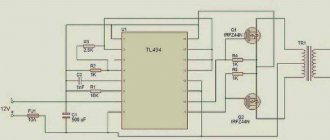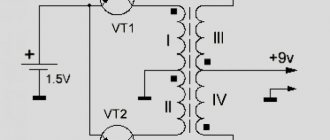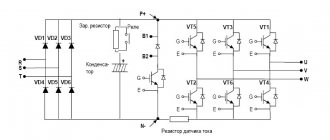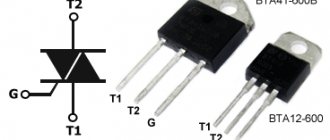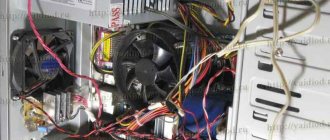General principles of multivibrator operation
As stated in the encyclopedia, “a symmetrical multivibrator is a two-stage amplifier covered by positive feedback.” Let's look at the diagram:
Rice. 1. Two-stage amplifier with positive feedback
If you have read the article about the amplifier stage on a transistor, then all the characters in this circuit are well known to you. This is a separating capacitor C, a base resistor Rb, which sets the bias current, and Rk as a load. And there are two such cascades here, they are absolutely identical.
What is unusual is the feedback wire (shown in red in the diagram), which closes our two-stage amplifier into a ring. It is thanks to positive feedback that our amplifier turns into an oscillator, controlling itself and maintaining undamped oscillations.
↑ List of sources
1. Mosyagin V.V. Secrets of amateur radio skills. – M.: SOLON-Press. – 2005, 216 p. (pp. 47 – 64). 2. Shustov M.A. Practical circuit design. 450 useful diagrams for radio amateurs. Book 1. – M.: Altex-A, 2001. – 352 p. 3. Shustov M.A. Practical circuit design. Monitoring and protection of power supplies. Book 4. – M.: Altex-A, 2002. – 176 p. 4. Low-voltage flasher. (Abroad) // Radio, 1998, No. 6, p. 64. 5. Datagorsk article “The main tool is a soldering iron!” 6. Datasheet article “Soldering SMD parts at home” 7. Datasheet on LM3909 8. Shoemaker Ch. Amateur control and alarm circuits on ICs. – M:.Mir, 1989 (diagram 46. Simple low battery indicator, p. 104; diagram 47. Painter marker (flashing), p. 105). 9. Generator on LM3909 // Radio circuit, 2008, No. 2. 10. Nahrada obvodu LM3909 // Prakticka electronic A Radio, 2009, No. 6, p. 22. 11. Odinets A.L. Unusual application of LM3909 // Radioamator, 2009, No. 12, p. 16. 12. Borisevich K. IC LM3909 in amateur radio designs // Radiomir, 2010, No. 1, p. 19. 13. Discrete Version Of The LM3909 Oscillator IC 14. Belousov O.V. Equivalent of IC LM3909 on parts for surface mounting // Radioamator, 2011, No. 11, p. 34, 35.
Turning on the power
At the first moment after turning on the power, both transistors begin to open. Where does the opening current come from? Let's look at the example of transistor T1
Rice. 3. Power-on moment: currents that open the transistor
The first, obvious path is through Rb1, blue arrow in the figure. The second, not so obvious, is through capacitor C1. Let's not forget that at the first moment of time the capacitor is discharged, its resistance is practically zero, and a charge current appears in the circuit through Rк2 - C1 - emitter junction T1. This path is shown with a red arrow.
It is important to note here that the collector resistances Rк in this circuit are significantly less than the basic ones Rb, at least by an order of magnitude, or even several. This means that the “red” component will make a greater contribution at the first moment.
↑ Conclusion
Surface mounting provides tangible advantages not only for industrial use, but also for radio amateurs.
It goes well with all types of traditional installation. Practice shows that even replacing 5 - 20% of conventional elements with leadless SMDs gives a very noticeable gain. The manufacture of a printed circuit board is simplified and the installation density increases. The length of the signal conductors is reduced, which reduces parasitic inductance, capacitance and resistance, and in turn, leads to a significant improvement in the electrical parameters of the product. From the materials of the portal forums it follows that radio amateurs use SMD parts when modifying finished products. And here the use of surface-mounted parts simplifies the task, since often there is no space left to install conventional elements.
An asymmetrical multivibrator using transistors of different structures serves as the basis for a lot of simple and useful designs [1 – 4, 7 – 14].
Despite the simplicity of the presented designs, their perfection should be noted, which is included in the epigraph of the publication.
Fight of transistors
However, both transistors do not have time to open completely. The fact is that, when opening, the transistor begins to interfere with its colleague. For example, as soon as T2 has a collector current, the potential on the right plate of C1 drops. In fact, the current through the capacitor begins to flow in the opposite direction: through Rb1 - C1 - collector junction T2:
Rice. 4. Direction of current through the opening transistor
It turns out that at the base of T1 the potential drops, T1 tends to close. But, closing, it accelerates the opening of T2, which leads to even greater locking of T1.
The same reasoning can be symmetrically applied to T2. That is, the transistors fight with each other, trying to open and at the same time close their neighbor.
Equilibrium does not occur here; in the end, one of the transistors necessarily wins and opens completely, going into saturation mode, while its colleague closes completely. The fact is that, even though our transistors are the same model, it is physically impossible to create two absolutely identical transistors. One of them will have a slightly higher gain, and this transistor will come out the winner. For definiteness, let us assume that T1 is closed and T2 is open.
How does a transistor multivibrator work?
The multivibrator actually works simply. When power is connected, two LEDs periodically light up and go out. The variable switching frequency of LEDs can be changed using capacitors or resistors connected to transistors and LEDs.
This device is in one of two opposite unstable states and periodically transitions from one to the other and back again. The transition phase is quite small relative to the long duration of stay in the states due to positive feedback (POF), which covers two amplification stages.
Let's assume that VT1 is closed, VT2 is fully open and saturated, while C1 is quickly charged by the open base junction current of VT2 through R1 and VT2 almost to the supply voltage. When capacitor C1 is fully charged through resistor R1, the current stops, the voltage on C1 = (base current VT2) R2, and on the collector VT1 - the supply voltage.
The electrical voltage at the collector VT2 is quite low (which in turn will be equal to the electrical voltage drop across the saturated transistor). C2, previously charged in the previous state (polarity as in the diagram), slowly begins to discharge through the open transistor VT2 and resistor R3. The current voltage at the base of transistor VT1 is negative and thanks to this voltage it is firmly held in the closed state. The voltage-closed state of transistor VT1 is maintained until capacitor C2 is recharged through R3 and the voltage at the base of VT1 begins to reach its full unlocking threshold (about +0.6 V).
At the same time, VT1 begins to immediately open slightly, and the voltage of its collector begins to rapidly decrease, which in turn causes the irreversible start of blocking VT2, the collector voltage of transistor VT2 begins to rapidly increase, which in turn, through capacitor C2, opens VT1 even more. As a result, an avalanche-like regenerative repeating process occurs in the transistor multivibrator, leading to the fact that VT1 goes into an open saturated state, and VT2, in turn, is locked.
Electrical oscillatory processes in the circuit will be constantly and periodically repeated, depending on the capacitance and resistance of the components and the coefficients of the transistors used.
Generation
All the processes described above occur very quickly, they are limited only by the speed of the transistors. After this, the circuit stabilizes and is in a stable state. However, this stability is only apparent, since some processes associated with the charge and discharge of capacitors continue:
Rice. 5. After switching transistors: fast charge C2 and slow charge C1
Firstly, capacitor C2 charges quite quickly - the resistance Rк1 is relatively small. In the figure, its charging path is shown with a red line.
If C2 has quickly charged and the current through it has stopped, what keeps T2 open? Answer: current through Rb2. This current, although less than through C2 at the first moment, is quite enough for the transistor to be completely open (in saturation mode).
Secondly, capacitor C1 also charges, but more slowly due to the relatively high resistance Rb1 - see the blue line in the figure. Note that the voltage on C1 is applied plus to the base of T1, and as C1 is charged, it increases. At some point (when the value reaches about 0.6 V), it will become sufficient to open T1, and this transistor will open.
And here C2 is waiting in ambush, already fully charged for a long time and tired from idleness. After T1 opens, it turns out that the entire accumulated potential of C2 is applied to the emitter junction of T2, and in the blocking polarity, which is why T2 instantly closes:
Rice. 6. When T1 opens, capacitor C2 closes T2
Explanation: The current does not flow along the red line, it only shows the direction of the potential. The fact is that the emitter junction T2 is blocked by this potential and its resistance is very high. Moreover, by closing, T2 accelerates the opening of T1, because the potential across its collector increases, and causes capacitor C1 to discharge even more through the emitter junction T1, opening it. What we get is an avalanche-like self-reinforcing process of simultaneous switching of transistors to the opposite state.
Well, then the events begin to repeat themselves symmetrically: C2 is slowly recharged in the opposite polarity, through Rb2 and the newly opened T1, until its potential becomes sufficient to open T2, and the transistors switch again, and so on.
Symmetrical transistor multivibrator
The principle of operation is to transition from one unstable state (Q1 closed, Q2 open) to another (Q1 open, Q2 closed).
Let's start with the first state: Q1 is closed, Q2 is open.
Capacitor C1 quickly charges through the “smaller” resistor R4 and the base junction Q2. At the same time, through open Q2, through the “larger” resistor R2, C2 is slowly discharged, the negative voltage on which keeps Q1 in a locked state.
In the process of further recharging C2, a positive unlocking voltage appears at the base of Q1, and Q1 begins to open. The current through it increases, the voltage at the collector of Q1 and the base of Q2 decreases, which causes it to turn off.
The voltage on the collector of Q2 increases and through the capacitor C2 opens Q1 even more.
The process of opening Q1 accelerates the closing of Q2, and the process occurs almost like an avalanche, and the transition from one state to another occurs very quickly.
Voltages on capacitor C1, base-emitter and collector-emitter of transistor Q2 Voltages on capacitor C1, base-emitter and collector-emitter of transistor Q2
In general, transistors periodically open and close each other.
Now a little about the calculation of elements.
The period consists of two parts t1 and t2, depending on the resistances R2, R3 and capacitances C1, C2:
t1 = 0.7 x R3 x C1;
t2 = 0.7 x R2 x C2
For example, in the circuit in the picture above, the period is t1 + t2 = 2*0.7*22 kOhm*0.1 µF = 3.08 ms.
Period 3.3 ms Period 3.3 ms
The duration of the decay of the pulses depends on the resistance of resistors R1 and R4: the lower the resistance, the faster the decay.
When R1 = R4 = 470 Ohm When R1 = R4 = 470 Ohm
The main disadvantage of this scheme is the slow declines. This shortcoming is corrected in the diagram:
Multivibrator frequency
Note that the charging of the capacitor through Rb continues for a relatively long time, but the switching of transistors occurs almost instantly. Therefore, the multivibrator generates rectangular pulses. And their frequency is determined by the charging time of the capacitors:
f = 1.443 / (C1*Rb1 + C2*Rb2)
where f is frequency (Hz), C is capacitance in farads, R is resistance in ohms
It remains to add a couple of technical notes. First: the multivibrator has two outputs, the signal can be removed from both the T1 collector and the T2 collector. These two signals are out of phase, some circuits take advantage of this property and use both signals. When connecting a load, it is important not to bypass the transistor, otherwise there is a risk of distorting the operation of the multivibrator, or even completely disrupting generation. It is best to connect the load in parallel with the collector resistance.
Well, the second note. It’s obvious, but without mentioning it, the article would be incomplete: we are analyzing here a circuit based on npn transistors, but in the same way, a multivibrator can be built on pnp transistors by changing the power polarity. And also on radio tubes, operational amplifiers, logic elements, etc. - the main thing is that there are two amplification stages covered by the OS. One of such schemes will be given below.
Methods for connecting a load to a symmetrical multivibrator
Rectangular pulses are removed from two points of a symmetrical multivibrator
– transistor collectors. When there is a “high” potential on one collector, then there is a “low” potential on the other collector (it is absent), and vice versa - when there is a “low” potential on one output, then there is a “high” potential on the other. This is clearly shown in the time graph below.
The multivibrator load must be connected in parallel with one of the collector resistors, but in no case in parallel with the collector-emitter transistor junction. You cannot bypass the transistor with a load. If this condition is not met, then at a minimum the duration of the pulses will change, and at a maximum the multivibrator will not work. The figure below shows how to connect the load correctly and how not to do it.
In order for the load not to affect the multivibrator itself, it must have sufficient input resistance. For this purpose, buffer transistor stages are usually used.
The example shows the connection of a low-impedance dynamic head to a multivibrator. An additional resistor increases the input resistance of the buffer stage, and thereby eliminates the influence of the buffer stage on the multivibrator transistor. Its value should be no less than 10 times the value of the collector resistor. Connecting two transistors in a “composite transistor” circuit significantly increases the output current. In this case, it is correct to connect the base-emitter circuit of the buffer stage in parallel with the collector resistor of the multivibrator, and not in parallel with the collector-emitter junction of the multivibrator transistor.
To connect a high-impedance dynamic head to a multivibrator, a buffer stage is not needed. The head is connected instead of one of the collector resistors. The only condition that must be met is that the current flowing through the dynamic head must not exceed the maximum collector current of the transistor.
If you want to connect ordinary LEDs to the multivibrator to make a “flashing light,” then buffer stages are not required for this. They can be connected in series with collector resistors. This is due to the fact that the LED current is small, and the voltage drop across it during operation is no more than one volt. Therefore, they do not have any effect on the operation of the multivibrator. True, this does not apply to super-bright LEDs, for which the operating current is higher and the voltage drop can be from 3.5 to 10 volts. But in this case, there is a way out - increase the supply voltage and use transistors with high power, providing sufficient collector current.
Please note that oxide (electrolytic) capacitors are connected with their positives to the collectors of the transistors. This is due to the fact that on the bases of bipolar transistors the voltage does not rise above 0.7 volts relative to the emitter, and in our case the emitters are the minus of the power supply. But at the collectors of the transistors, the voltage changes almost from zero to the voltage of the power source. Oxide capacitors are not able to perform their function when connected with reverse polarity. Naturally, if you use transistors of a different structure (not NPN, but PNP structures), then in addition to changing the polarity of the power source, you need to turn the LEDs with the cathodes “up in the circuit”, and the capacitors with the pluses to the bases of the transistors.
Let's now figure out what parameters of the multivibrator elements determine the output currents and the generation frequency of the multivibrator?
What do the values of collector resistors affect? I have seen in some mediocre Internet articles that the values of collector resistors do not significantly affect the frequency of the multivibrator. This is all complete nonsense! If the multivibrator is correctly calculated, a deviation of the values of these resistors by more than five times from the calculated value will not change the frequency of the multivibrator. The main thing is that their resistance is less than the base resistors, because collector resistors provide fast charging of capacitors. But on the other hand, the values of collector resistors are the main ones for calculating the power consumption from the power source, the value of which should not exceed the power of the transistors. If you look at it, if connected correctly, they do not even have a direct effect on the output power of the multivibrator. But the duration between switchings (multivibrator frequency) is determined by the “slow” recharging of the capacitors. The recharge time is determined by the ratings of the RC circuits - base resistors and capacitors (R2C1 and R3C2).
We recommend reading: LM358 microcircuit: datasheet in Russian, application, analogues, pin assignments
A multivibrator, although it is called symmetrical, this refers only to the circuitry of its construction, and it can produce both symmetrical and asymmetrical output pulses in duration. The pulse duration (high level) on the VT1 collector is determined by the ratings of R3 and C2, and the pulse duration (high level) on the VT2 collector is determined by the ratings R2 and C1.
The duration of recharging capacitors is determined by a simple formula, where
Tau is the pulse duration in seconds, R is the resistor resistance in Ohms, C is the capacitance of the capacitor in Farads:
Thus, if you have not already forgotten what was written in this article a couple of paragraphs earlier:
If R2=R3 is equal
and C1=C2, at the outputs of the multivibrator there will be a “meander” - rectangular pulses with a duration equal to the pauses between pulses, which you see in the figure.
The full period of oscillation of the multivibrator – T is equal to the sum of the pulse and pause durations:
The oscillation frequency F (Hz) is related to the period T(sec) through the ratio:
As a rule, if there are any calculations of radio circuits on the Internet, they are meager. Therefore, we will calculate the elements of a symmetrical multivibrator using an example.
Like any transistor stages, the calculation must be carried out from the end - the output. And at the output we have a buffer stage, then there are collector resistors. Collector resistors R1 and R4 perform the function of loading the transistors. Collector resistors have no effect on the generation frequency. They are calculated based on the parameters of the selected transistors. Thus, first we calculate the collector resistors, then the base resistors, then the capacitors, and then the buffer stage.
Working circuit
To clearly demonstrate the operation of the multivibrator, I assembled a circuit on a breadboard. I placed an LED in series with Rk1 and Rk2.
The part numbers are as follows:
- T1, T2 - C1815
- Rk1, Rk2 - 1 kOhm
- Rb1, Rb2 - 47 kOhm
- C1, C2 - 10 µF (electrolytic, connected positive to the collector, negative to the base)
- Supply voltage - 5 V.
Rice. 7. Working multivibrator model
↑ SMD installation practice: let's make a talisman souvenir
Let's start mastering surface mounting using SMD components.
Let’s assemble a “flashing light” to use as a souvenir – a talisman. The printed circuit board and placement of elements of the light pulse generator are shown in Fig. 5. There are no holes in the board, and there is no power switch. You can turn off the power to the device by placing a small strip of paper between the GB1 battery terminal and the clamp terminal.
Rice.
5. Printed circuit board and placement of elements of the light pulse generator The small size of SMD components requires special care and accuracy in installation.
You cannot do without a soldering iron with electronic temperature control, because overheating of the elements is completely unacceptable, as it will cause a loss of contact with the leads of the part. Mastering surface mounting should be an incentive to purchase at least a simple soldering station and special tweezers (Fig. 6, 7).
Rice. 6. One of the simple Hakko 937 soldering stations
The Hakko 937 soldering station belongs to the category of simple soldering stations and is perfect for beginner radio amateurs and household soldering work, as an excellent replacement for a regular soldering iron. This soldering station has small dimensions of 230×170*120 mm.
The delivery set includes a convenient soldering iron stand with a tray for cleaning the soldering tip.
This soldering station, despite its small dimensions, has a power of 60 W. The front panel contains digital indicators and controls. The operating temperature of the tip can be set from 200° to 480°C.
The soldering station is equipped with a removable ergonomic soldering iron with replaceable tips. The soldering iron heats up to the desired temperature in a matter of seconds.
Rice. 7. High quality stainless steel tweezers
Precision straight dental tweezers are an indispensable thing when working with every little thing, especially with SMD. High-quality “food grade” stainless steel is used as material for the manufacture of tools.
Before you begin installation, read useful articles on Datagor; the advice they contain will help you avoid gross mistakes and quickly master the basics of soldering [5, 6].
For ease of soldering, select the following sequence for installing elements on the printed circuit board: VT1 –> VT2 –> C1 –> R3 –> R1 –> R2 –> C2 –> R5 –> R4 –> HL1 –> battery clamp terminal GB1.
With proper installation and serviceable elements, the “flashing light” immediately begins to work, and will please its owner for more than a year before the next battery replacement.
Alternative schemes
Let's look at several alternative circuits, as well as some ways to improve the performance of the multivibrator.
Multivibrators with adjustable frequency and duty cycle
Rice. 8. Multivibrator circuit with adjustable frequency (left) and duty cycle (right)
In the left circuit, due to the variable resistor, the values of Rb change, which means the frequency of the generator. On the right, the sum Rb1 + Rb2 remains unchanged, but the ratio of resistances in the base circuits changes. Thus, the frequency is fixed, but the duty cycle (the ratio of pulse length and pause) changes. Strictly speaking, this is already an asymmetrical multivibrator.
Multivibrator with improved waveform
If you carefully read the explanation of the operation of the multivibrator above, you remember that after switching the transistors, one of the capacitors is quickly recharged through the collector resistor Rk (see Fig. 5, red line). However, since the useful signal is removed precisely from the collector, the voltage changing on the capacitor introduces completely unnecessary interference into this signal. In the circuit in the following figure, an additional resistor is introduced, through which the same capacitor charge occurs:
Rice. 9. Separate the charging and discharging paths of capacitors: improving the signal shape
The capacitor is separated from the collector by a diode, which prevents the capacitor from distorting the front of the pulse at the moment the transistors are switched. But this same diode perfectly allows the capacitor to charge during the quasi-stable state of the multivibrator between switchings through Rb - diode - open transistor.
Multivibrator based on logical elements
Rice. 10. Multivibrator based on 2I-NOT elements
For an alternative logic multivibrator circuit, see this article.
Three-phase multivibrator
Rice. 11. Three-stage multivibrator circuit
Here, not two cascades are connected in series, but three. The circuit works in such a way that at any given time 2 transistors are open and one is closed. You can try to understand the operation of this circuit yourself, using the description of a symmetrical multivibrator above as a basis.
Rice. 12. Working model
Share on social networks:
↑ Integrated circuit LM3909
An asymmetrical multivibrator using transistors of different structures, shown in Fig. 2, served as the prototype of the LM3909 monolithic integrated circuit (IC) from National Semiconductor, designed specifically for power supply from galvanic cells with a voltage of 1.5 V [7]. Devices based on it are highly economical and provide a long service life without replacing batteries.
A simplified circuit diagram of the LM3909 is shown in Fig. 8. Only two hanging elements are used: LED HL1 and capacitor C1, which determines the frequency of the generated pulses and at the same time participates in the operation of the “voltage boost” circuit. This allows you to work with LEDs that have a forward voltage drop of 1.6...2.0 V at a supply voltage of 1.5 V or less.
The maximum supply voltage of the microcircuit should not exceed 6 V. To protect the microcircuit when operating at the threshold of maximum supply voltages, a zener diode VD1 is used.
Devices based on the LM3909 chip can be used in toys, promotional items, warning indicators, etc. The use of the LM3909 IC is discussed in a number of amateur radio literature [1, 7 – 13].
Multivibrator in its design
Having once made a multivibrator flasher on a breadboard, I wanted to refine it a little - make a normal printed circuit board for the multivibrator and at the same time make a scarf for the LED indication. I developed them in the Eagle CAD program, which is not much more complicated than Sprintlayout but has a strict connection to the diagram.
Multivibrator printed circuit board on the left. Electrical diagram on the right.
Printed circuit board. Electric scheme.
I printed the drawings of the printed circuit board on photo paper using a laser printer. Then, in full accordance with the folk tradition, he etched the scarves. As a result, after soldering the parts, we got scarves like this.
To be honest, after complete installation and connecting the power, a small bug occurred. The plus sign made from LEDs did not blink. It burned simply and evenly as if there was no multivibrator at all.
I had to be pretty nervous. Replacing the four-point indicator with two LEDs corrected the situation, but as soon as everything was returned to its place, the flashing light did not blink.
It turned out that the two LED arms were connected by a jumper; apparently, when I tinned the scarf, I went a little overboard with the solder. As a result, the LED “hangers” lit up synchronously rather than at intervals. Well, nothing, a few movements with a soldering iron corrected the situation.
I captured the result of what happened on video:
In my opinion it turned out not bad.

